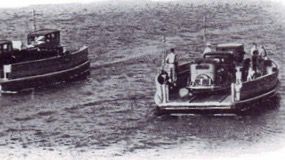NEWPORT BEACH, Calif. — For over a year, Seymour Beek has held on.
Profits for the iconic Balboa Island Ferry had already plummeted because of wage and insurance increases. Then the pandemic shuttered and slowed business for the better part of a year.
Visit Newport Beach, a local tourism bureau, is now projecting a big year for local businesses, and Seymour hopes he’ll get a lifeline.
“I think this might be a record-breaking year,” he said. “We certainly need it.”
At 87, Seymour still handles the big decisions, holding daily hours at the office located at 410 South Bayfront in Balboa Island.
Seymour has run the ferry since 1990 — 81 years after it was first established. In those days, the island was largely residential, covered in two-way streets. The island got its first traffic signal in the 1940s, shortly after 14-year-old Seymour got his driver’s license.
Residents there used the ferry each morning to get to work or school. At first, service was inconsistent, and passengers who relied on it to get from their homes on Balboa Island needed a sure thing. That’s when the city of Newport Beach put the contract up for a bid. Joseph Beek, Seymour’s father, put in the winning bid.
Joseph had come to town to dabble in real estate and would one day develop some of the city’s most expensive areas like Harbor Island and Beacon Bay. He’d never thought about becoming a ferry operator. Once he saw how dysfunctional the operation was, he decided to give it a try.
He won the bid in 1919 and began making the short trip in an 18-foot skiff with an outboard engine.
Over the years, Joseph replaced the ferries with new ones he had custom-made. Car transportation began slowly. Staff had two-by-fours and wooden planks at the ready to lay over the sand in front of the boarding ramp. At first, it could transport one Ford-Model T at a time. Larger replacements came later that could carry two, then three cars.
In the 1950s, the latest versions of the Balboa Island ferries were built. Seymour said those are still in operation, with inboard John Deer engines, some of which have gone 50,000 hours before major repairs.
When Joseph passed away in 1968, the family hired managers to keep things running until Seymour stepped in. The lifelong Newport Beach resident has been on the water since he was six, sailing on the city’s shores. He was already planning to leave his job as an aerospace engineer.
“I’m very good at delegating. They do everything,” he said.
The city gets 5% revenues, which Seymour hopes will be about $2 million this year. He’s expecting traffic to be high. On an average year, the three boats can ferry 350,000 cars and 1.6 million people.
Seymour isn’t sure how big this season will be and can never tell this time of year. July Fourth weekend, one of the ferries’ busiest, is sure to give him some idea. That’s when the ferries will run at capacity. The 64-foot boats can carry 100 people at $1.25 a head, or $1.50 for an adult with a bicycle.
Half the riders take the three or four-minute ride for fun. Others use it to get to work or for shopping. Limited parking and traffic drive many to the ferry.
With restrictions on dining lifted and relaxed mask ordinances, local businesses are preparing for a boost in activity on the city’s beach fronts. The ferry may face further increases and expenses and could raise fare prices.
Even so, this summer could get the business back on track.
“I’m hoping to raise wages again,” Seymour said. “A year-long freeze is too long.”



